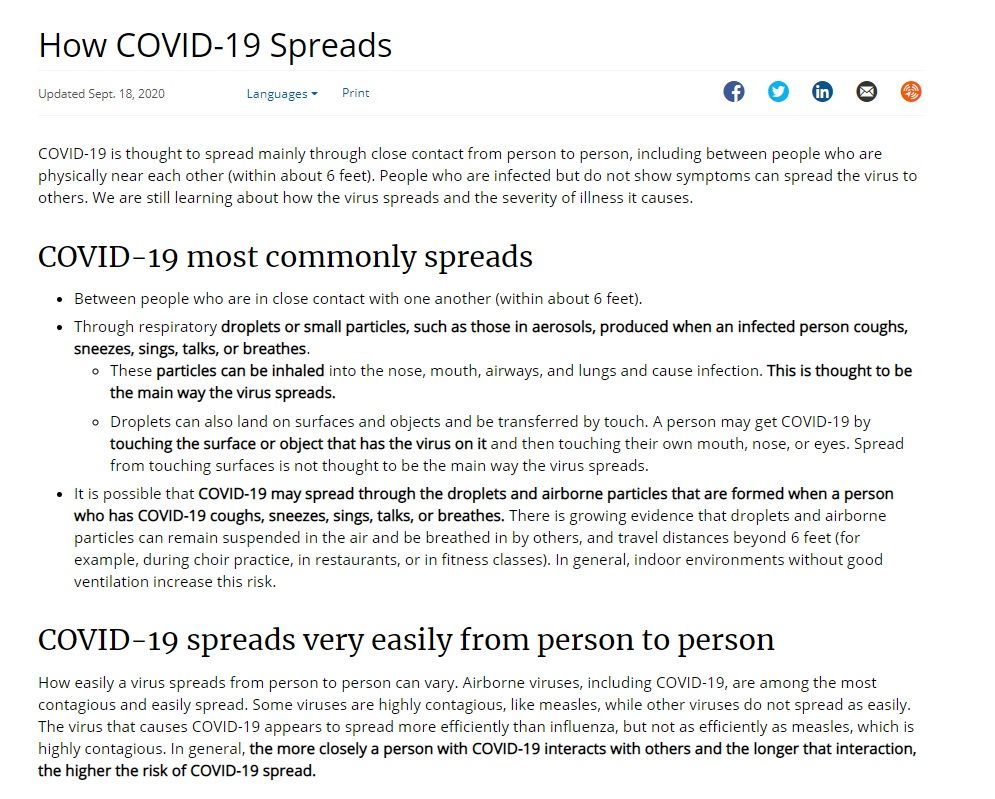
こんなことだろうと思ってました。
CDCが新型コロナのエアロゾルを介した感染を撤回
How COVID-19 Spreads (COVID-19の広がり方) 2020年9月21日更新
A draft version of proposed changes to these recommendations was posted in error to the agency’s official website. CDC is currently updating its recommendations regarding airborne transmission of SARS-CoV-2 (the virus that causes COVID-19). Once this process has been completed, the update language will be posted.
これらの勧告に対する変更案のドラフトバージョンが、誤って政府機関の公式ウェブサイトに投稿されました。CDCは現在、SARS-CoV-2(COVID-19を引き起こすウイルス)の空中伝播に関する勧告を更新しています。このプロセスが完了すると、更新文が掲載されます。
CDCは新型コロナのエアロゾルを介した感染についての勧告を出していましたが、21日にさらに更新して撤回しました。その理由は草案が誤掲載されたというものです。
では、撤回前はどう書かれていたのか?
CDCのSARS-Cov-2のエアロゾル感染に関する草案

How COVID-19 Spreads (COVID-19の広がり方) Updated Sept. 18, 2020
Through respiratory droplets or small particles, such as those in aerosols, produced when an infected person coughs, sneezes, sings, talks, or breathes.
These particles can be inhaled into the nose, mouth, airways, and lungs and cause infection. This is thought to be the main way the virus spreads.
Droplets can also land on surfaces and objects and be transferred by touch. A person may get COVID-19 by touching the surface or object that has the virus on it and then touching their own mouth, nose, or eyes. Spread from touching surfaces is not thought to be the main way the virus spreads.
It is possible that COVID-19 may spread through the droplets and airborne particles that are formed when a person who has COVID-19 coughs, sneezes, sings, talks, or breathes. There is growing evidence that droplets and airborne particles can remain suspended in the air and be breathed in by others, and travel distances beyond 6 feet (for example, during choir practice, in restaurants, or in fitness classes). In general, indoor environments without good ventilation increase this risk.How easily a virus spreads from person to person can vary. Airborne viruses, including COVID-19, are among the most contagious and easily spread. Some viruses are highly contagious, like measles, while other viruses do not spread as easily. The virus that causes COVID-19 appears to spread more efficiently than influenza, but not as efficiently as measles, which is highly contagious. In general, the more closely a person with COVID-19 interacts with others and the longer that interaction, the higher the risk of COVID-19 spread.
要所だけ指摘すると、「SARS-Cov-2は飛沫やエアロゾルなどの小さな粒子を介して感染する、これがウイルスが感染する主要な経路であり、接触感染は主要感染経路ではない。COVID-19は飛沫や浮遊粒子を介して感染拡大する、COVID-19含む空中伝播するウイルス感染症は感染性が高い。SARS-Cov-2はインフルエンザより感染性が高いが、非常に高い感染力を持つはしかよりは低い」と書いています。
この書き方は非常に紛らわしいと言えます。
空中伝播することと主要感染経路が空気感染だということ
どうも、このあたりの理解が医学者(医療従事者)や関連学問の専門家の中でもブレてるので困っているのですが、「空中を介して伝播すること」と、「主要感染経路が空気感染」であることには差があるという認識が伝統的な理解のようです。
飛沫核じゃないよ特定条件下のエアロゾルだよ3密回避有効だよ激しい呼気は要注意だよ、って話だいぶ前から言われてるのに定期的に空気感染報道で騒ぐのやめません?
— EARLの医学ツイート (@EARL_Med_Tw) 2020年9月22日
だから、"droplet nuclei"が入ってないものを「空気感染」と訳しちゃあきません。 https://t.co/0omXm8wgaT
— Y Tambe (@y_tambe) 2020年9月21日
もっとも、専用の感染対策がなされている現状、新型コロナが「空気感染」に分類されようが、やるべきことは変わりません。
人間が決める分類が変わったからと言ってウイルスの毒性や感染性が高まることはありませんので。
以上